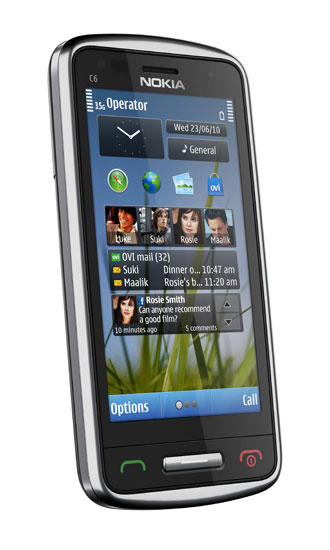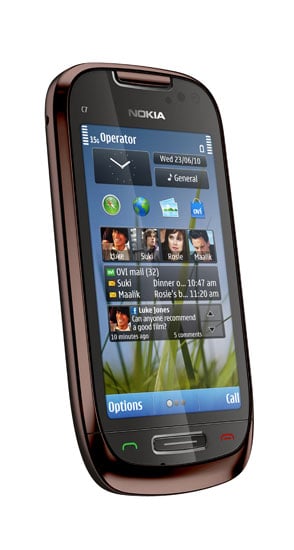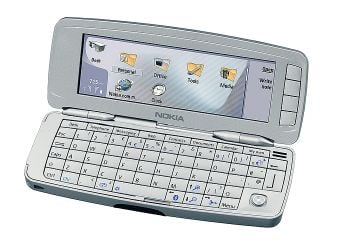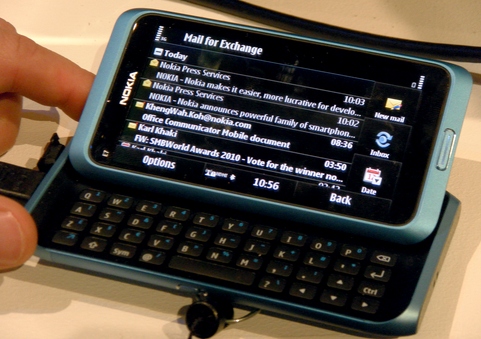Original URL: https://www.theregister.com/2010/09/14/nokia_hands_on/
Hands-on with the new Nokias
Two Cs and an E. Is that a pass grade?
Posted in Networks, 14th September 2010 13:44 GMT
Nokia World Nokia added three new models alongside the imminent N8 today. All are Symbian^3 based; two are in the C-range*, but one was billed as the Son of Communicator – a quite extravagant claim that might quicken the pulse of a few Reg readers. Would any of these live up to their billing? I had a quick hands-on with all three, let's have a look.
I found all three offer a considerably better user experience than anything touchy Nokia offers today. They have great new screens. On the down side, the styling and design is conservative and very 'so what?' and none offer anything splashy to to the high-end consumer. Nokia's design ideas now seem largely theoretical – designed for consistency in a portfolio presentation rather than in real life. I remember when the company would throw odd, unusual and interesting designs at the market every year. But I gather these new phones may not be intended to break new ground – this year is really a holding operation for the new UIs and Linux-based devices to be introduced in 2011. These, of course, remain unseen and unannounced.
All three S^3s announced today are essentially close cousins of the N8. Confusingly, one of them is an S^3 update to an existing model number with a non-too-stellar reputation and a different form factor – the C6. This revised 'C6-01' has no QWERTY keyboard.
In photographs, all the new models look almost identical – only the C6-01's call and end buttons distinguish it from the others. In reality the C6-01 is smaller and much squatter, and like its predecessor appears to be designed to go after the price conscious user, who might be tempted by a mid-range touchscreen phone, say from Samsung or LG.
The rather classier C7 is larger with a 3.5inch display, and is very thin, at only 10.5mm. It has much of the N8's DNA but lacks the high-end multimedia specifications – with only an 8MP camera, and no HDMI out. I expect that Nokia expects slimness to command a premium, rather than high-end features. But I'm not sure why, with the Nokia N8 sure to be available at reasonably competitive prices, you'd prefer a C7. If you're going to get something in this price bracket (there's only apparent $70 between them at full unsubsidized retail price) you'd want to go for the phone that does one thing really well.

Looks familiar: Nokia N6-01.
As for the C6-00, the much smaller, information-dense screen is the nicest thing about it. It's targeted at social media 'tards, but the social media experience on Symbian phones even in the S^3 incarnation is still pretty cronky.
All three new models feature an excellent ClearBlack Display screen, with lower reflectivity and a much deeper black. Great screens used to be one of Nokia's hallmarks, and these are the best for some time. All have a 640x360 resolution. The Symbian^3 UI has been tied up considerably, with many of the redundancies and inconsistencies removed - and with decent processors powering all these models, I only found one common function showed any lag.

Nokia C7: Again, a completely uninspired industrial design doesn't do this justice.
Under the hood, Symbian remains the best mobile operating system a manufacturer could choose, with its maturity and ultra-aggressive power management. That's never really been in question. Symbian^3 is really what Nokia should have brought to the market in late 2007 or early 2008. But even with the UI cleanups it's really no more than what a 2008 phone should deliver. Nokia knows, and won't need to be reminded, how much time has been lost through the complacency with which it greeted the iPhone, and the terrible waste of two years as Symbian was acquired, spun out and open-sourced.
But the model that may most readers is the E7, the first new Nokia QWERTY phone for power users.
'Nothing beats a real keyboard'
Departing phone boss Anssi Vanjoki boldly declared that the E7 is the heir to the communicator, and spent a lot of time celebrating Nokia's welding a PDA to a phone, in the Nokia 9000. And at first sight, with its large four-inch display, you wonder if it fulfils the promise. In practice though, it's more honest to describe it as a much improved N97. To many users of the Symbian 6.0 and 7.0-based Communicators , with their Psion heritage largely intact, the comparison will be heresy, because two of the things to make up a Communicator – rich application software and an optimized keyboard – are absent.

For example, the E7 has a large four-inch screen (640x380 pixels). But the time Vanjoki devoted to 9000 nostalgia allowed us to notice that the monochrome brick displayed much more information on its screen than the 21st-century counterpart. Even Nokia's pen-based 2005 UI offered much more richness, and made very advanced functionality quite accessible. But then that's because it was designed from the ground-up to be a touch-screen UI - the true successor to the original Commie.
The other area where it falls down, if comparisons must be made, is with the sub-par keyboard.

The Nokia E7
“Nothing beats a real keyboard,” but this isn't a real keyboard, as any veteran of the 80-key Communicators will tell you. The Communicator designers devoted as much space as they could to a keyboard. With the E7, as with the N97, the angled screen represents form over function – it sucks up 40 per cent of available surface area for what might otherwise be used for the QWERTY keyboard.
So things move on, and they don't always go forward.
If can you forget the Communicator comparison, the device fares rather better. Build quality is outstanding, and it has that rare combination of robustness and lightness – particularly welcome in a quite wide device. The keyboard is much more positive in its action than the N97, being firm and clicky. The E7 retains the folding hinge of the notorious N97, too, but uses an extra row of keys. (The Communicators had six rows – the sixth devoted to application keys.) Nimble fingers might be able to use more than thumbs, and spider two or three fingers onto the keyboard - something you could last do on an 9500, but not particularly comfortably.
There are small improvements to the messaging app – here seen running Mail For Exchange – but it's the weakest point of the built-in software suite. Power users will still want to download ProfiMail and Opera. Elsewhere it has the same performance and usability tweaks seen across the new Symbian^3 devices. Scrolling through the gallery is near-instant, just as on an iPhone, and finding and calling contacts is greatly improved.
It evidently isn't a dedicated data UI. For example, the text label of the social networking application is truncated to 'Social Netwk.'. This is typical of a UI that was designed for one-handed use then, with a squeal of the brakes, retro fitted to do Touch.
My disappointment is that despite Savander's claim that it produces lots of models to cater to the very different needs of its users, there still isn't something optimised to QWERTY fans.
In his farewell keynote, Vanjoki made the bold claim that "Nokia is back" – but this is more about stemming the haemorrhage of Nokia users both to whizzy new platforms and mid-range rivals. Next year, and a range of new devices, might allow Nokia to claim leadership once again. The company will probably be glad to put 2010 behind it. ®
*C is for “consumer”. Or for “common”.